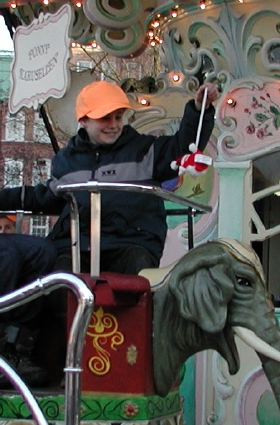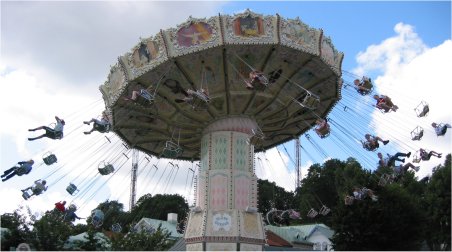Sara Bagge and Ann-Marie PendrillPhysics and Engineering Physics,
Göteborg University and Chalmers University of Technology
SE-412 96 Göteborg
Sweden
Ann-Marie.Pendrill@fy.chalmers.sePhysics Education, Nov 2002, p 507-511
Abstract
An amusement park is a large physics laboratory, full of rotating and accelerated coordinate systems. The forces are experienced throughout the body and can be studied with simple equipment or with electronics depending on age and experience. In this paper, we propose adaptations of classical physics experiments for use in traditional rides.
In this paper on using an amusement park in physics education, we propose adaptations of the classical experiments by Foucault and Eötvös, using rides commonly available also at travelling carnivals or at the seaside fair ground.
Many of the rides in an amusement park involve high elevations, fast movements and strong forces. Safety issues must thus always be taken seriously. In the first experiment described, however, the park may be more concerned about the well-being of the antique horses in the merry-go-round. Whenever planning experiments for a class, find out the rules of the park, and if needed, negotiate possible exceptions in advance. The experiments proposed in this paper require only very simple equipment that is unlikely to harm anyone, even if dropped.
"A scientist is completely isolated inside a smoothly moving box that travels a straight-line path through space and another scientist is completely isolated in another box that is spinning in space." /3/ Can any or both of the scientists detect the motion? The students may have learnt that it is impossible to detect uniform rectilinear motion, but the question still creates considerable discussion in a class of new students, especially with the added proviso that "Each scientist may have all the scientific goodies she likes in her box for the purpose of detecting her motion in space." /3/. A common reaction is that it must somehow be possible. Students might suggest, e.g., that the air would tend to stay behind. Not all are convinced by a mathematical demonstration of the translational invariance of Newton's laws. Can the scientist detect if the box is spinning? Here students quickly suggest using the centrifugal force - the Foucault pendulum is certainly not part of their experience. Distinguishing the fundamental difference that translation is relative whereas rotation is absolute is not easy for the student - let them try this experiment!
"It made a star, it made a star." An exalted 9-year old tells his teacher and his friends and anyone who will listen. He draws the figure with his hand. Many children, in fact, do observe, and those who do are happy to share and discuss their observations - others just let the animal swing and look everywhere else.

Figure 1. What happens to the swinging toy as the carousel starts?
The miniature Foucault pendulum is a striking experiment, even more so for more slowly rotating systems. It is usually appreciated by the older students, but can small children really learn anything from it? In December 2001, a class of 10-year olds visited the park, doing a number of experiments, starting with this one, using their own toys, so they knew that no-one had cheated. One of the teachers brought up the question why we would do this, so the question how we can know that the Earth rotates was discussed. The visit took place just before Christmas, and the class teacher had no time to follow up on their experiences. Three months later, we visited the class and interviewed the children. Many of them recalled the pendulum in the carousel, and also that it had something to do with the rotation of the earth, commenting e.g.:
"In the Pony Carousel, the cuddly toys on the strings started to move like this. I think it was to prove that the Earth is rotating.""I learned that when going in the Pony Carousel, the cuddly toy kept going in the same direction while I was going around."
How does a teacher move on from here to make use of the children's observations, which also involves taking different systems for reference. One possibility is to find a carousel on a local playground and try it with e.g. a water pistol or throwing balls to a friend. A difficulty may be that safety regulations seem to make carousels on playground few and far between. A more serious concern, however, is that the teacher may not share the children's excitement. Russell Stannard /4/, who interviewed several scientists observes that "An essential ingredient for appreciating science is the sense of wonder. ... I am struck by the marked change that come over young people as they enter their early teens. Too often an air of bored indifference sets in and the precious sense of wonder is to a large sense lost, never to be regained. ... The scientists I have spoken to still possess it".
We have found that adults without physics training often have difficulties with this experiment. If they remember anything about inertial forces, it is certainly not the Coriolis force. Instead of letting the object swing, they typically let it hang still and wait for the centrifugal force to make it hang to the side. However, the centrifugal force is not very eye-catching in slowly rotating coordinate systems. Visual studies of horizontal acceleration is more rewarding in other rides, e.g. in the wave swinger discussed in the next section.

Figure 2: What determines the angle?
The wave swinger is a beautiful illustration of the equivalence principle. The angle between the swings and the vertical is determined by the ratio between the centripetal force and the weight. Since the inertial mass (entering the centripetal force, ma) and the gravitational mass (entering the weight, mg), are equal, the angle is independent of the mass. Eötvös used the rotating earth as a giant wave swinger by letting weights of different material balance from a rod suspended as a torsion balance. Refined Eötvös experiments are still performed, e.g. at the Eöt-Wash group at the University of Washington in Seattle, giving lower and lower limits for possible deviations from the equivalence principle./5/ The most well-known classical test of the equivalence principle is, of course, Galileo's experiment dropping balls of various size from the leaning tower in Pisa. Many large parks now have drop towers that give the riders a chance to experience a long free fall. Experiments utilising these rides will be discussed in a later paper.
Children are naturally interested in their weight and often ask how heavy they feel in various rides. For the case of the Wave Swinger the apparent weight can be estimated easily by using a protractor to measure the angle between the swings and a suitable vertical line. Older children may divide the reading on the bathroom scale by the cosine of the angle. Younger children can draw their normal weight as a vertical leg of a right-angled triangle, using the reading from the protractor for the top angle. The horizontal leg corresponds to the centripetal force and the hypothenuse to the total force exerted by the chain on the rider. The apparent weight can thus be read directly from the hypothenuse in the diagram. We will return to the question of g-forces in a later paper.
A simple experiment in the Wave Swinger is to take along a small mug of water. This violates the general rule of "no lose objects" and thus requires some negotiation. During a class visit, we asked a 9-year old if she had had problems to take the mug along. She proudly told us that the guard had asked if she was really going to take the mug on the ride, but that she had told him that she came from a school and was going to do an experiment. Nevertheless, this experiment may be better saved for later years - we saw a number of mugs breaking under the squeeze by excited kids trying to hold on during the ride.
What happens to the water level in the mug? During the year 2001, about ten classes of 14-16-year olds who visited Liseberg during the Gothenburg International Science Festival filled in a quiz including this question (without doing the experiment). About a third of the pupils thought that the water level would be parallel to the ground, half of them thought that it would be parallel to the seat and the rest chose the alternative that the direction would be between the horizontal and the seat. Later interviews with children indicate that many believe that the water level would lean more than the swing. For the experiment to be rewarding, it seems essential to first have made a guess. An adult came off the ride wondering if she had made something wrong, because nothing happened to the water. Some children are surprised to see that the water stays in the mug (and happy to drink it on a hot day). Others exclaim "It is amazing. The water level remained absolutely still." Yes, indeed, the water level is orthogonal to the plumb line, represented in this case by the chain, but even if you know this, you may be surprised by the extent to which it is true.
The preparations are essential. Without them, the originally intended use of an amusement park is too tempting for the students to be able to concentrate on the physics. Physics is fun - but it is also important to help the students discover that "the fun is physics".
We thank professor Ference Marton for discussions about children experimenting with acceleration and rotation and Lasse Haglund who provided a class of well-prepared 10-year olds, and also let us interrupt lessons for interviews. Finally, we would like to express our deep appreciation of the Liseberg amusement park, for generously making the park available for experiments - in physics, as well as in education - and to the guards who let children feel welcome and important, when they perform experiments.